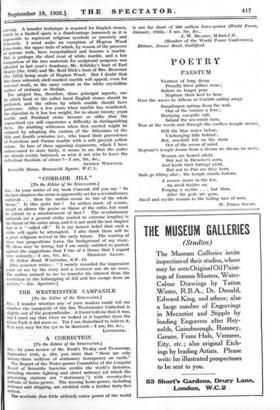THE RIGHT STONE FOR CHURCHYARD MONUMENTS [To the Editor of
the SPECTATOR.] SIR,—There have at times appeared in some of our principal newspapers articles and correspondence on the question whether local stone or marble should be used for churchyard monuments. This interest has doubtless been aroused by the report of the special committee appointed by the British Institute of Industrial Art to enquire into the present position of monumental art in Great Britain. A similar attitude on the question cited characterizes both this report and the newspaper comments and the opinions of their correspondents, namely, that of encouraging the use of local stones at the expense of marble.
The chief objection to white marble, expressed most aptly in the committee's report and in the Times leading article of April 8th, appears to be that it is artistically unsuitable in an English churchyard or cemetery, or, to quote the com- mittee's report, that " it is not well suited to harmonize with the subdued tones of the English sky and natural surround- ings " (p. 12). This, of course, is a very sound objection. As it is an attitude that is more concerned with the country churchyard than the city cemetery, I will concentrate on that. All will agree that the desirable effect in a churchyard is that the monuments shall be of the same stone as the church, so that, all weathering similarly, a beautiful harmony is achieved. To realize this would mean reviving many cid quarry industries for the sole purpose of ensuring that monuments in certain churchyards shall be of the same stone as the church that has in most instances stood for centuries. This is obviously out of the question. Resource then can be had to those English building stones in present use that are the most suitable for this purpose, such as Portland, Hopton Wood, Blue Pennant and Hornton. The soft hues of these stones will certainly harmonize with the grey walls of an old church better than will white marble. Thus it may be concluded that in considering landscape effect only, local and softer hued English stones should be preferred to white marble ; but there are yet two other aspects of the subject equally important : the personal sentiment of those who erect the memorial, and the aesthetic value of the memorial considered in itself.
The sentimental preference for white marble is naturally very strong. During the earlier part of the nineteenth century, when many Protestants objected to the use of the Cross symbol, because they considered it hostile to the spirit of the reformers who held that its use was abused by Roman Catholics, J. H. Marldand, writing on Churches and Memorials, notes with satisfaction the revival of its use " in the churchyard of Tor Mohun in Devonshire, in a monument, placed by a clergyman to the memory of his daughter, which consists of a small and simple cross of pure white marble placed upon a black marble pedestal " (4th edition, 1847, p. 188). Well, that phrase, " pure white marble," and the picture it is meant to convey express excellently the sentiment that attends its choice. That white marble is a symbol of spiritual purity is fairly strongly rooted in most people's minds, especially when they are thinking of funerals and monuments. And further, whiteness, according to the early Christian notion like the cross on the coffin, is supposed to be a protection from malignity or evil intent. Nesse, writing in 1680, in his Church History, says that " God chequered his providence with the black of Misery and the white of Mercy " (p. 110). That sentiment will be quite sufficient to prompt many people to choose a tombstone as white as can be obtained. It is of interest to observe that it was the custom among the Romans to keep a white stone to commemorate an endearing M propitious event.
Aesthetically considered, without relation to their sur- roundings, Sicilian and statuary marbles are generally admitted to be superior to all other sculptural materials, as they afford an unrivalled scope for subtlety and delicacy of
carving. A broader technique is required for English stones, which in a limited space is a disadvantage inasmuch as it is impossible to represent religious symbols so precisely and delicately. I must make an exception of Hopton Wood Limestone, the upper beds of which, by reason of the presence of igneous rock, have recrystallized and become a marble This is perhaps the chief rival of white marble, and a fair comparison of the two materials for sculptural purposes was afforded in last year's Academy, Mr. Schilsky's bust of Earl Beatty (No. 1241) and Mr. Reid Dick's bust of Mrs. Bessemer (No. 1275) being made of Hopton Wood. But I doubt that this fawn coloured, hell-inarked -marble will. appeal, even for external .work, to the same extent as the white crystalline surface of statuary or Sicilian.
The subject has, therefore, three_ principal aspects, one by which local or the Softer hued English stones should be preferred, and the others by which marhle should have preference. After a few years when marble has weathered, the objection to it has less weight, for in about twenty years marble and Portland stone become so alike that :the. unpractised eye will experience a difficulty in distinguishing them. Its startling whiteness when first erected might be subdued by Adopting the custom. of the Athenians of the fifth and fourth centuries who toned their gravestones of Pentelican and Parian marble with a soft greyish yellow colour. In face of these oppoSing arguments, which I have endeavoured to state fairly, it seems to me that the scales are almost evenly balanced, so were it not wise to leaVe the individual freedom of choice ?—I am, Sir, &c.,
ARNOLD WHITTICK.
Grenville House, Brunswick Square, W.C.1.































































 Previous page
Previous page